Have you seen Spotted Lanternfly?
Main_Content
Figure 1- (Credit: Lawrence Barringer,
PA Department of Agriculture)
| Figure 2- (Credit: Lawrence Barringer,
PA Department of Agriculture)
|
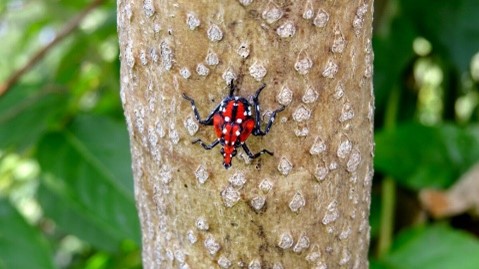
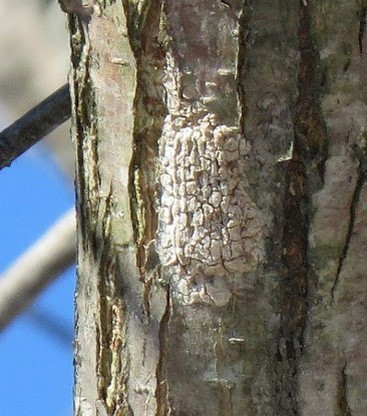
Figure 3 - (Credit: Alejandro Calixto, NYSIPM)
| Figure 4 - (Credit: Massachusetts
Department of Agriculture)
|
A picture is required when submitting a report. Submitting a report does not trigger a response from our team and is not considered a request for more information. If you have any questions or concerns, please email us at
[email protected].
We are taking reports from every county in Maryland.
Spotted Lanternfly Basics
|
Spotted Lanternfly (Lycorma delicatula) is a planthopper native to eastern Asia. In 2014 a stone shipment was sent to Berks County PA with spotted lanternfly in tow. Since then, we have had confirmed sighting in 18 states including Maryland. Our first sighting was in 2018 in Cecil County. As of 2025 we have seen spotted lanternfly in 20 of our 23 counties, including Baltimore city.
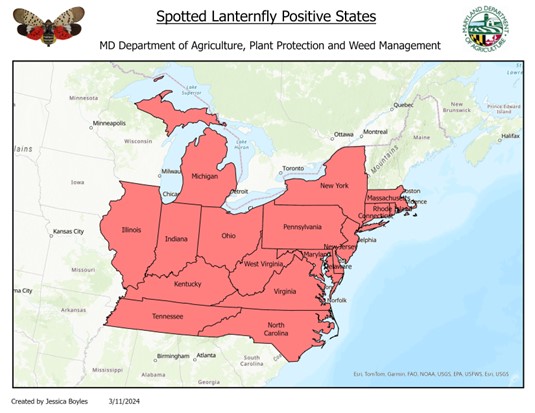 ![]()
Regardless of these sightings, we are still taking reports from every county. The data provided in our reporting tool allows us to better apply our resources. |
![]()


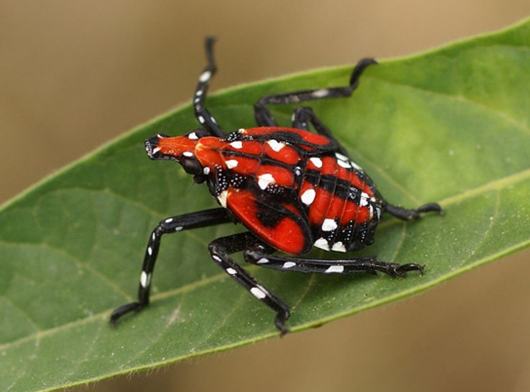
Figure 5 - (Credit: Dalton Ludwick)
| Figure 6- (Credit: New Jersey Department of Agriculture)
|
Early Instar Nymphs – they hatch from April to June. Early instar nymphs grow until they molt in July. You will find them on newer growth including saplings.
| 4th Instar Nymphs – we see 4th instar nymphs beginning in April. They are distinctively red and show a more prominent wing pad. They will continue to grow until they molt into adults.
|

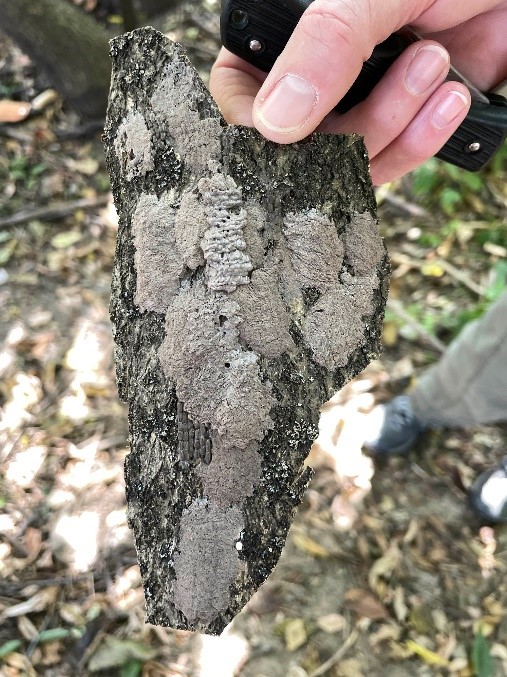
![]()
![]()
Figure 7 - (Credit: Lawrence Barringer, PA Department of Agriculture)
| Figure 8 - (Credit: Spotted Lanternfly Team, Maryland Department of Agriculture)
|
Adults – They are about 1inch in length. They have bright red hind wings, that you will not see when their wings are closed. They can be found as early as July, but emergence depends on the weather. They will remain active till the first freeze. Females will begin to lay eggs in September and will continue to do so until first frost.
| Egg Masses – Typically egg masses are laid on host trees, Though they can be seen on any flat surface, including fences, wood piles, cars, tires, trash cans, etc. Eggs are laid in rows and then covered with a greyish coating. A female can lay up to 3 masses. They are commonly mistaken for a splash of mud or dirt. They will survive the winter and then hatch in the spring.
|
Hosts of spotted lanternfly – The primary host of spotted lanternfly is tree of heaven (Ailanthus altissima). Tree of heaven is also an invasive species, which has been in the U.S for hundreds of years. However, spotted lanternflies have about 70 secondary hosts including: wild and cultivated grape, black walnut, red maple, silver maple, weeping willow.
Figure 9- Full tree of heaven. You see the flowers at the top. (Credit: Sairus Patel,
Aug 8th 2018)
| Figure 10- Bark of tree of heaven. The bark is smooth, but has a distinctive cantaloupe pattern (Credit: Ryan Bohannon, NC State University)
| Figure 11- Leaves of tree of heaven are composed of individual leaflets. (Credit: Ryan Bohannon, NC State University)
|
Spotted lanternfly can be found feeding on tree of heaven at all life stages. More information about tree of heaven can be found
here.
How does Spotted Lanternfly affect Maryland?
|
Spotted lanternfly pose a risk to local Maryland vineyards, can impact our local ecosystem, and are a nuisance to Maryland citizens.
Spotted lanternfly do not feed on flowers, leaves or fruit. Instead, they eat phloem or sap from the trunks and stems of their host plants. They are also non-toxic if ingested by pets. Spotted lanternfly will not bite or sting you. They pose no danger to you or your pets. Spotted lanternfly feeding is a significant stressor. Though we have not seen plant death due to spotted lanternfly alone. It has been shown to stunt growth, reduce crop yields and cause localized damage.
|

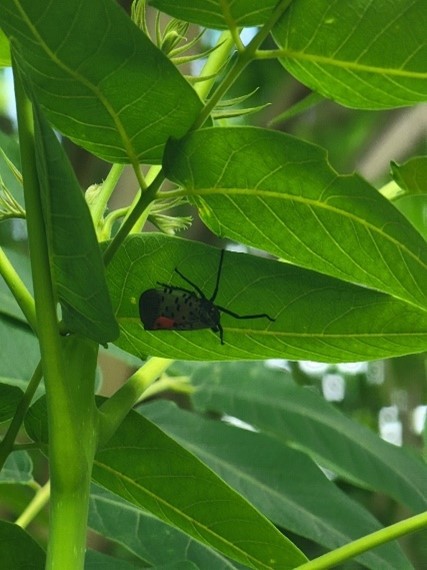
![]()
Figure 12 - (Credit: Jessica Boyles,
Maryland Department of Agriculture)
| Figure 13 - (Credit: Jessica Boyles,
Maryland Department of Agriculture)
|
Maryland vineyards are at unique risk from spotted lanternfly feeding. We have seen a reduction in winter hardiness and a reduction in yield due to spotted lanternfly feeding.
Honeydew is excreted by spotted lanternfly. It is made up of sugar and water. Honeydew will sit on leaves and create something called sooty mold. This sooty mold will reduce the plants' ability to photosynthesize. When it sits on decks, furniture, cars and other outdoor furniture or equipment, it can become sticky and difficult to remove. Spotted lanternfly can hitch a ride on cars, trains, trucks and other equipment. The ability to hitchhike allows them to move quicker across our state and into our neighboring states. We ask that everyone check vehicles and other equipment before moving it, Especially if you are aware of spotted lanternfly in your area.
Physical difference between early nymphs, 4th instar nymphs and adults cause most to second guess themselves when identifying. Spotted lanternfly molt as they develop. Freshly molted spotted lanternfly will appear pink. Their molts fall to the ground and can mistaken for dead spotted lanternfly.
|
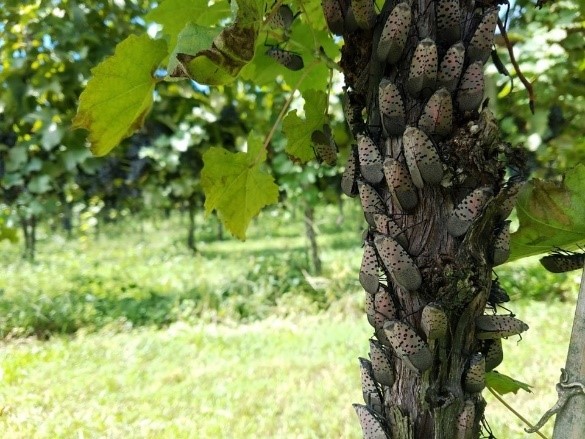


Figure 14 - (Credit: Heather Leech, Penn State University)
| Figure 15 - (Credit: Jessica Boyles, Maryland Department of Agriculture)
| Figure 16 - (Credit: Jessica Boyles, Maryland Department of Agriculture)
|
Homeowner Management of Spotted Lanternfly
|
The Maryland Department of Agriculture does not have the resources for any residential treatment of spotted lanternfly or tree of heaven. Eradication of spotted lanternfly is not something that is feasible at this moment. However, management of spotted lanternfly is possible and can provide relief. We will highlight recommended management tactics and information here. However, you can find more information on spotted lanternfly at the following sites: |
![]()
 Figure 17 - (Credit: Stephen Ausmus, USDA-ARS)
|
Mechanical Control: This is our recommend method for spotted lanternfly management. These methods are the least environmentally impactful. They are also easily accessible to every Maryland citizen. - Flyswatters and nets are easy ways to catch and kill spotted lanternfly.
- Hand vacuums or shop vacuums can remove spotted lanternfly from vegetation and structures around your property. Spotted lanternfly caught can simply be thrown away.
- Circle traps are a great way to passively trap spotted lanternfly. They do not require a lure or any chemicals. Spotted lanternfly are poor flyers and climb up trees to feed on stems and jump to glide to their next location. The circle trap cut off access to the tops of trees and funnels them into a plastic bag. This bag can be replaced and the old one thrown away. We do not recommend sticky tape or glue traps, as they have a high rate of by-catch, Often leading to beneficial insects, small mammals, reptiles and even birds getting caught. You can purchase pre-built traps online. Or you can follow a tutorial here to build one yourself. It is important to remember that the mesh must wrap around the entire tree. If not spotted lanternfly can by-pass the trap. It can be necessary to use two traps to fully cover a tree.
- Removal of egg masses in the winter is also effective. Every egg mass you remove is 30 – 50 less spotted lanternfly that will hatch in the spring.
|
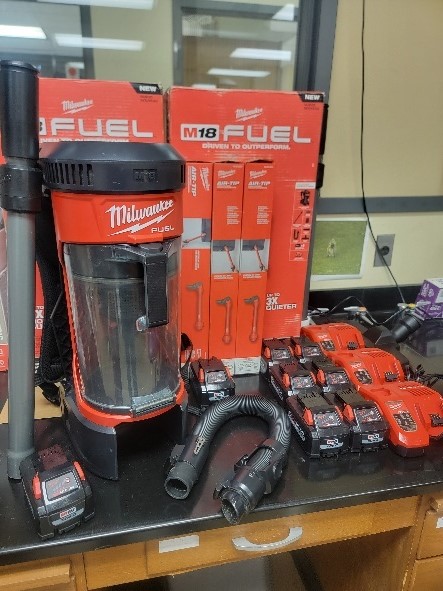

Figure 18 - (Credit: Maryland Department of Agriculture)
| Figure 19 - (Credit: Rick Lathorp)
|
Chemical Treatment: There are no insecticides on the market that will exclusively kill or repel spotted lanternfly from a property. Chemical treatment would require repeated treatments, which can be costly. Certain insecticides should only be used by professionals. It is also important to not treat your lawn for spotted lanternfly, as they do not reside in lawn grass and will not be impacted. - Specific information on chemical insecticides you can use can be found by contacting your local University of Maryland Extension office. You can fill out a request form here.
- We cannot recommend specific pest companies as we are the regulatory agency.
The Maryland Department of Agriculture does not have the resources to conduct chemical treatment at residential properties. For questions concerning what your county offers, Reach out to your local University of Maryland extension office or your county specifically.
|
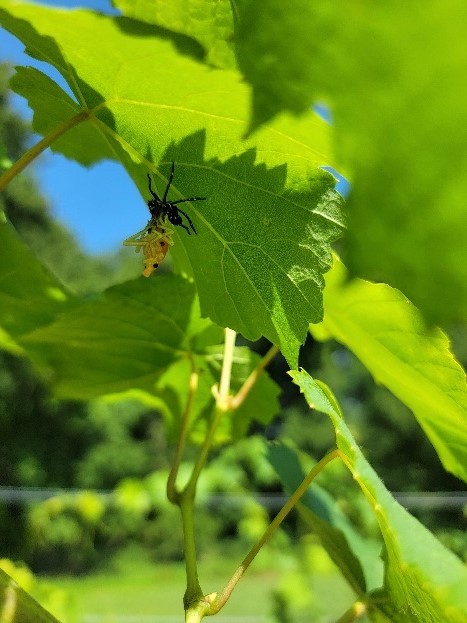
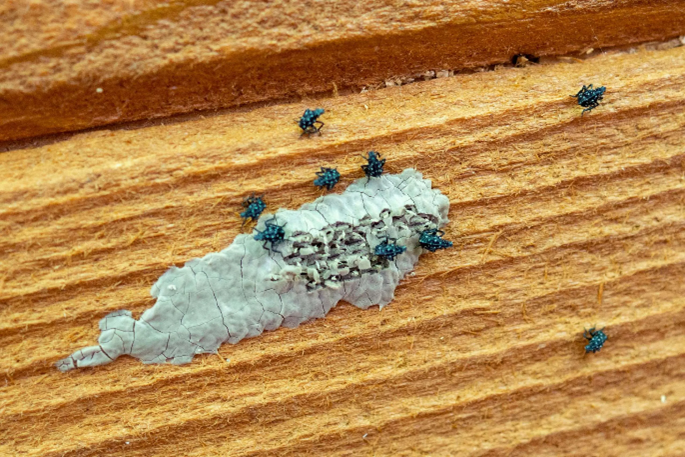
Figure 20 A and B- (Credit: Jessica Boyles, Maryland Department of Agriculture)
|
Tree of Heaven Management: Tree of Heaven is also an invasive species. If you have tree of heaven on the property you can remove it. The Maryland Department of Agriculture does not have the resources to remove tree of heaven for you. To successfully remove tree of heaven you will need to completely remove its roots system. Cutting it down will trigger a defense mechanism resulting in shoots emerging around the base of the cut tree. More information on controlling tree of heaven can be found here.
Using tree of heaven as a “trap" tree is a recommended spotted lanternfly management method. Setting up circle traps on these trees can result in mechanical removal of spotted lanternfly.
Removal of other plant hosts is not recommended. Removal of tree of heaven will also not guarantee spotted lanternfly will avoid or leave your property.
|

![]()
Figure 21 - (Credit: Stephen Ausmus, USDA-ARS)
|
Permitting and Spotted Lanternfly Quarantine
|
The Secretary of Agriculture has issued a quarantine order for 20 Maryland Counties, including Baltimore city. Businesses and institutions are required to be permitted if they move regulated articles from or within the quarantined area. Permitting is free and only needs to be undertaken by a single representative. That person can then train others on the identification and property management of spotted lanternfly. Permits from other states are entirely reciprocal with Maryland. Be prepared to present your permit if questioned by a MDA inspector. Persons found to be in violation of the Secretary's quarantine order are liable for civil penalty per each violation. The list of regulated articles, the definition of person required to obtain permits, as well as the parameters of the civil penalty can be found in the text of the Secretary of Agriculture's quarantine order here.
Residents should utilize the checklist for homeowners and the homeowners guide to spotted lanternfly. Thoroughly inspect all items presented on the list for any life stage of spotted lanternfly and destroy them if discovered. This will help slow the spread of spotted lanternfly, Not just to our neighboring states, but to other Maryland communities so far unaffected.
|
![]()
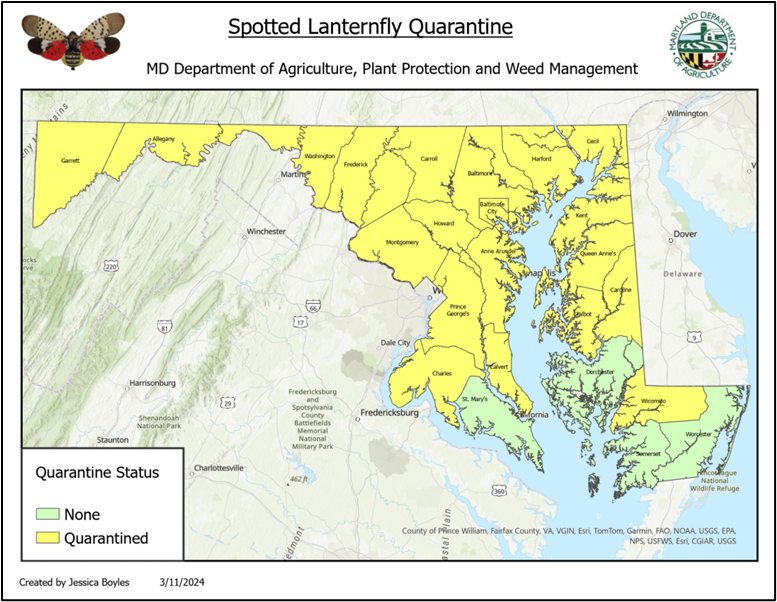
![]()
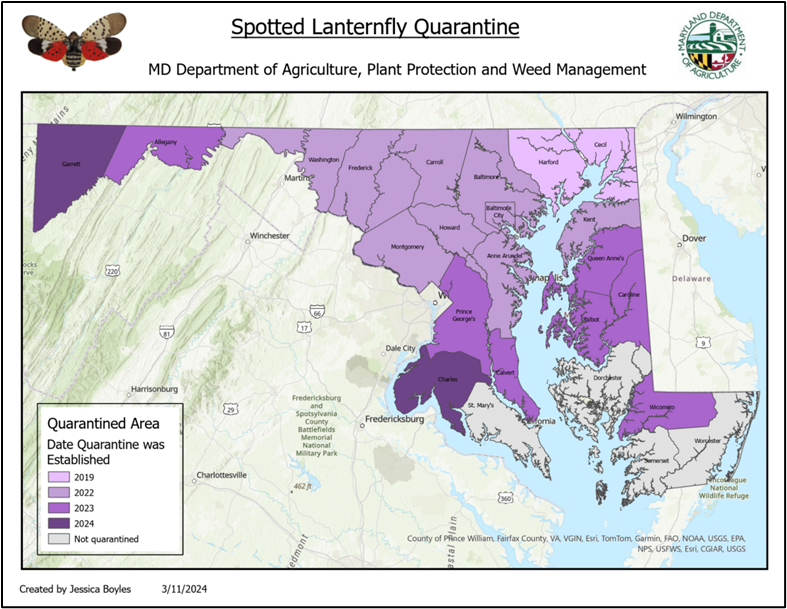
Figure 22 - (Credit: MDA's Spotted Lanternfly Team)
| Figure 23 - (Credit: Alexandra Benedik, Maryland Department of Agriculture)
|
